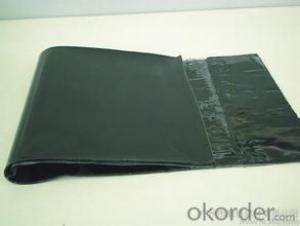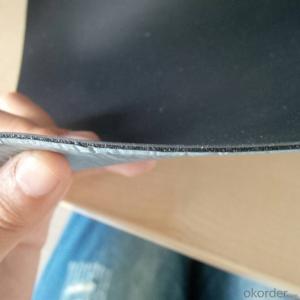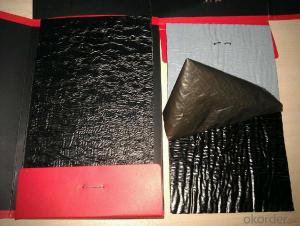Self adhensive Modified Waterproof Membrance
- Loading Port:
- Tianjin
- Payment Terms:
- TT or LC
- Min Order Qty:
- 10000 m²
- Supply Capability:
- 15000000 m²/month
OKorder Service Pledge
OKorder Financial Service
You Might Also Like
Quick Details
Type: | Waterproof Membrane | Place of Origin: | Shandong, China (Mainland) | Brand Name: | CMAX |
Model Number: | Excaid-D | thickness:1.2mm,1.5mm,2.0mm: | Raw mateiral:EPDM rubber | width:1200mm: | Standard:GB18173.1--2006 |
length:20m: | Tear strength:>=25KN/m | break tensile strength >=7.5MPa: | waterproof:0.3MPa,30min | break elongation:>=450%: | usage:building waterproof |
Packaging & Delivery
Packaging Details: | PE membrane and pallet |
Delivery Detail: | within 20 days after receiving downpayment |
Specifications
1.ISO9001,ISO14001
2.Top 3 of Chinese waterproof materials manufacturer
3.Customize product property
4.System accessories
Technical Specification:
Type | Waterproof Membrane | |||
Material | EPDM RUBBER | |||
Thickness | 1.2mm; 1.5mm;2.0mm | |||
Weight(kg/m2) | 1.2mm | 1.5mm | 2.0mm | |
1.54-1.58 | 1.79-1.83 | 2.25-2.29 | ||
Length | 20m/Roll | |||
Width | 1.2m | |||
Usage | basements, ponds, Lake, steel structure roofing, underground, tunnels etc. | |||
Packing | 24 sqm/ROLL | |||
Loading in Container | ROLLS | |||
Colors | customized | |||
Enclosure | ||||
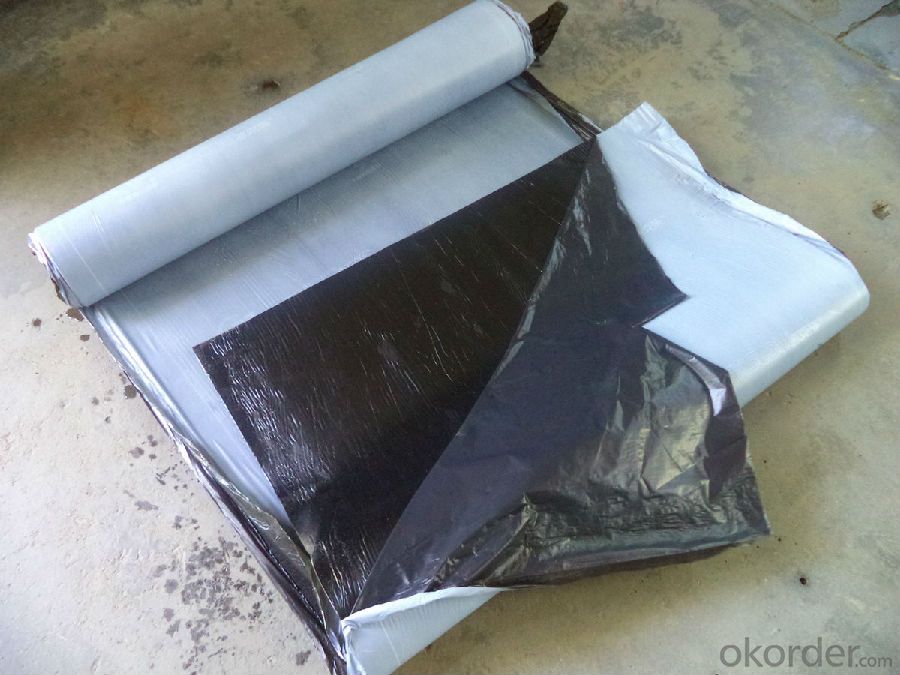
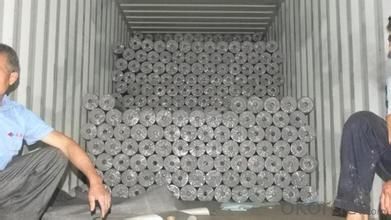
- Q:SBS Shale Waterproof Coil
- Features: low temperature flexibility is good, to -25 ℃ does not crack; high heat resistance, 90 ℃ does not flow. Good extension performance, long service life, simple construction, small pollution and so on. Products for Ⅰ, Ⅱ level building waterproofing works, especially for low temperature cold areas and structural deformation of the frequent building waterproofing works.
- Q:Can a waterproofing membrane be applied over existing coatings?
- Yes, a waterproofing membrane can be applied over existing coatings. However, it is important to ensure that the existing coating is in good condition and properly adhered to the surface. Any loose or damaged areas should be repaired before applying the waterproofing membrane to ensure its effectiveness.
- Q:Does a waterproofing membrane require any curing time before it can be exposed to water?
- Yes, a waterproofing membrane does require a curing time before it can be exposed to water. The curing time allows the membrane to fully bond and develop its maximum strength, durability, and waterproofing properties. The exact curing time can vary depending on the type of membrane and the manufacturer's instructions. It is important to follow these instructions to ensure that the membrane is properly cured and can effectively protect against water intrusion. Failing to allow sufficient curing time can compromise the effectiveness of the membrane and may lead to leaks or other issues. Therefore, it is recommended to wait until the specified curing time has elapsed before exposing the waterproofing membrane to water.
- Q:How does a waterproofing membrane perform in areas with chemical exposure or solvents?
- A waterproofing membrane is designed to protect surfaces from water penetration and damage. However, its performance in areas with chemical exposure or solvents may vary depending on the type of membrane and the specific chemicals involved. In general, waterproofing membranes are not specifically designed to resist chemical exposure or solvents. While they may provide some level of resistance to certain chemicals, prolonged exposure or contact with aggressive chemicals can compromise their effectiveness. Chemicals can potentially degrade the membrane material, causing it to become brittle, crack, or lose its waterproofing properties over time. To enhance the performance of a waterproofing membrane in areas with chemical exposure or solvents, it is recommended to use a chemical-resistant membrane specifically designed for such environments. These specialized membranes are made of materials that have been tested to withstand the effects of various chemicals and solvents. They offer a higher level of protection and durability, ensuring longevity and preventing damage caused by chemical exposure. It is important to note that the choice of the appropriate waterproofing membrane for areas with chemical exposure or solvents should be made based on the specific chemicals involved and their concentration. Consulting with a professional waterproofing contractor or manufacturer is advisable to ensure the selection of the most suitable membrane for the intended application. Regular inspection and maintenance are also crucial to monitor the performance of a waterproofing membrane in chemical-exposed areas. Any signs of deterioration, such as cracks, leaks, or discoloration, should be addressed promptly to prevent further damage and potential water infiltration. Overall, while a waterproofing membrane can provide some level of protection in areas with chemical exposure or solvents, it is recommended to use a specialized chemical-resistant membrane for long-term performance and durability.
- Q:Can a waterproofing membrane enhance the durability or lifespan of a structure?
- Yes, a waterproofing membrane can definitely enhance the durability and lifespan of a structure. A waterproofing membrane is a protective layer that is applied to the exterior of a structure, such as a building or a bridge, to prevent water penetration. This membrane acts as a barrier, preventing the water from seeping into the structure and causing damage. Water is one of the most common and destructive elements that can impact the longevity of a structure. When water infiltrates a building or any other type of structure, it can lead to a multitude of issues such as mold growth, deterioration of building materials, corrosion of metal reinforcements, and even structural instability. By installing a waterproofing membrane, these risks can be significantly reduced or even eliminated altogether. The application of a waterproofing membrane not only helps to prevent water ingress but also protects the structure from other environmental factors like moisture, humidity, and freeze-thaw cycles. It acts as a shield against these elements, ensuring that the building materials remain intact and reducing the likelihood of cracks, leaks, and other forms of structural damage. By enhancing the durability of a structure, a waterproofing membrane can greatly extend its lifespan. The membrane serves as a long-term investment, as it helps to prevent costly repairs and maintenance caused by water-related issues. By keeping the structure dry and protected, it adds years or even decades to its lifespan, saving both time and money in the long run. In conclusion, a waterproofing membrane is an essential component in maintaining the durability and lifespan of a structure. By preventing water infiltration and protecting the building materials from damage, it ensures the longevity of the structure and provides peace of mind to its owners and occupants.
- Q:Does a waterproofing membrane require any specific cleaning or maintenance procedures?
- To ensure the longevity and effectiveness of a waterproofing membrane, it is necessary to follow specific cleaning and maintenance procedures. Regular cleaning and maintenance are important to prevent the accumulation of debris, dirt, and contaminants that could compromise the membrane's ability to keep water out. The exact procedures for cleaning and maintenance may vary depending on the type of waterproofing membrane used, but there are some general guidelines to follow. Firstly, it is crucial to frequently inspect the membrane for any signs of damage, such as cracks, tears, or deterioration. If any issues are found, they should be addressed promptly to prevent further damage. When it comes to cleaning, it is recommended to use a soft-bristle broom or a leaf blower to remove loose debris or dirt from the membrane surface. It is important to avoid harsh chemicals or abrasive materials that could harm the membrane. Instead, a mild detergent or specialized cleaning solution recommended by the manufacturer should be used. The surface can be gently scrubbed with a soft brush or sponge and thoroughly rinsed with clean water. Additionally, it is vital to keep the surrounding drainage systems clear and free from obstructions. Regular inspection and cleaning of gutters, downspouts, and drains are necessary to ensure proper water flow and prevent potential water damage. Lastly, it is advisable to have the waterproofing membrane professionally inspected and maintained on a regular basis. This will help identify any potential issues early on and ensure that the membrane is functioning optimally. By following these specific cleaning and maintenance procedures, the lifespan of the waterproofing membrane can be prolonged, and its effectiveness in preventing water infiltration can be maintained.
- Q:Can a waterproofing membrane be applied in cold weather?
- Yes, a waterproofing membrane can be applied in cold weather. However, there are certain considerations that need to be taken into account. It is important to use a membrane that is specifically designed for cold weather applications as some membranes may not perform optimally in low temperatures. Cold weather can affect the curing process of the membrane, so it is crucial to follow the manufacturer's guidelines regarding temperature limitations and application techniques. The surface to be waterproofed should also be clean and dry before applying the membrane, as moisture or ice can interfere with adhesion. In cold weather, it may take longer for the membrane to fully cure and achieve its maximum performance. Therefore, it is advisable to allow sufficient time for the membrane to dry and cure before exposing it to water or other stressors. It is also important to note that extreme cold temperatures can negatively impact the installation process and the overall effectiveness of the waterproofing system. Therefore, it is recommended to consult with a professional waterproofing contractor who has experience working in cold weather conditions to ensure the best results.
- Q:Can waterproofing membranes be used on concrete block walls?
- Concrete block walls can indeed benefit from the use of waterproofing membranes. It is actually quite common and highly advised to employ such membranes on concrete block walls in order to ward off water infiltration and potential moisture-related harm. These membranes are specifically engineered to establish a barrier against water and can be effectively applied to either the exterior or interior surface of the concrete block walls. In doing so, they furnish an added layer of safeguarding, thereby preventing moisture from penetrating the walls and causing issues such as the growth of mold, efflorescence, and the deterioration of the concrete blocks themselves. By opting for the utilization of waterproofing membranes, you can effectively ensure the long-lasting resilience and durability of your concrete block walls.
- Q:Can waterproofing membranes be used on concrete pipes?
- Yes, waterproofing membranes can be used on concrete pipes. These membranes provide a protective barrier against water infiltration, preventing any potential leakage or damage to the concrete pipes.
- Q:Are waterproofing membranes resistant to chlorine exposure?
- The resistance of waterproofing membranes to chlorine exposure can vary. Certain membranes are designed to withstand chlorine and are commonly used in areas like pool decks or water treatment facilities where chlorine exposure is expected. These membranes are typically made with materials like PVC or TPO that naturally resist chlorine and can endure prolonged exposure without significant damage. It is important to be aware that not all waterproofing membranes are resistant to chlorine. Some membranes, particularly those made with materials like EPDM or bitumen, may not hold up as well against chlorine and may deteriorate or sustain damage with extended exposure. To ensure a waterproofing membrane lasts and performs well in a chlorine-rich environment, it is vital to choose a membrane specifically designed and tested for chlorine resistance. Seeking guidance from a waterproofing professional or manufacturer can assist in determining the most suitable membrane for the particular chlorine exposure conditions.
1. Manufacturer Overview |
|
|---|---|
| Location | |
| Year Established | |
| Annual Output Value | |
| Main Markets | |
| Company Certifications | |
2. Manufacturer Certificates |
|
|---|---|
| a) Certification Name | |
| Range | |
| Reference | |
| Validity Period | |
3. Manufacturer Capability |
|
|---|---|
| a)Trade Capacity | |
| Nearest Port | |
| Export Percentage | |
| No.of Employees in Trade Department | |
| Language Spoken: | |
| b)Factory Information | |
| Factory Size: | |
| No. of Production Lines | |
| Contract Manufacturing | |
| Product Price Range | |
Send your message to us
Self adhensive Modified Waterproof Membrance
- Loading Port:
- Tianjin
- Payment Terms:
- TT or LC
- Min Order Qty:
- 10000 m²
- Supply Capability:
- 15000000 m²/month
OKorder Service Pledge
OKorder Financial Service
Similar products
New products
Hot products
Hot Searches
Related keywords

